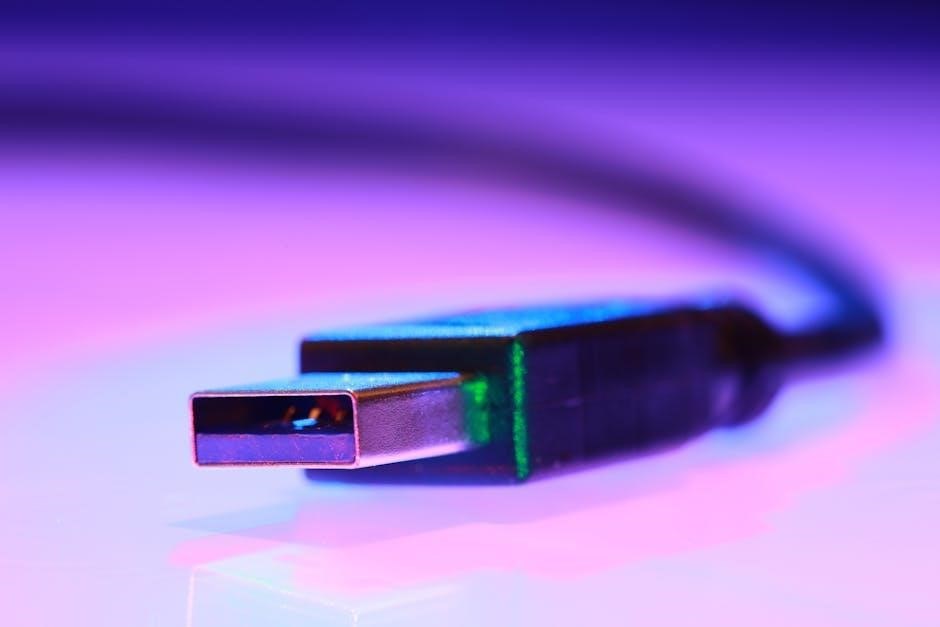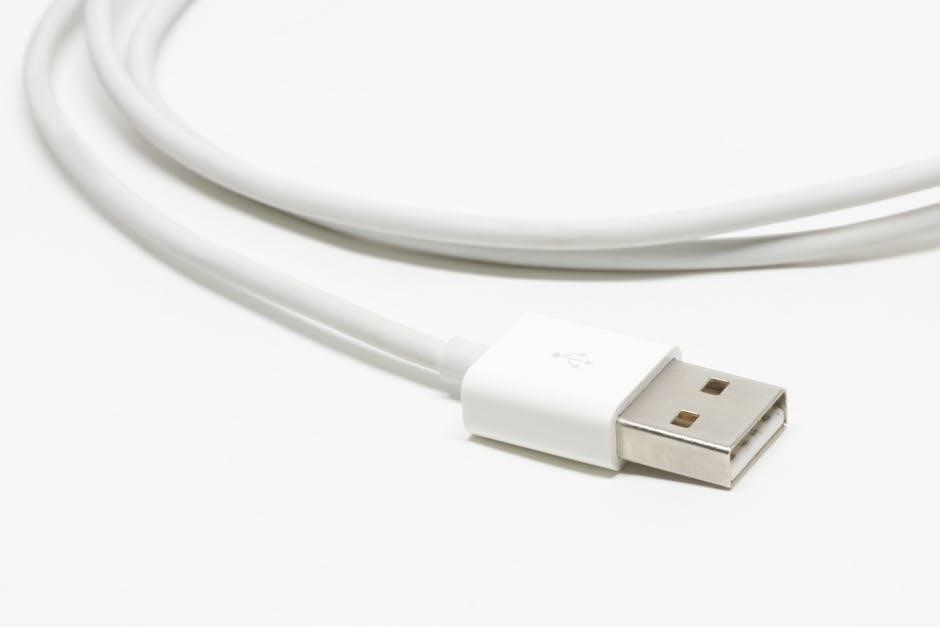A USB connector types chart provides a clear visual guide to understanding the various USB connectors, such as USB-A, USB-B, and USB-C, and their compatibility with different devices and standards.
1.1 Overview of USB Connectors
USB connectors come in various types, including USB-A, USB-B, USB-C, Mini-B, and Micro-B, each designed for specific purposes. USB-A is the standard rectangular port, commonly used for computers and chargers, while USB-C is the newer, versatile, and reversible connector. These connectors serve different needs, from data transfer to power delivery, and have evolved to meet modern technology demands.
1.2 Importance of Understanding USB Connector Types
Understanding USB connector types is crucial for ensuring compatibility and optimal performance. Different connectors support varying data transfer speeds and power delivery capabilities. By recognizing USB-A, B, C, Mini-B, and Micro-B connectors, users can select the right cables for their devices, enhancing functionality and preventing potential damage from mismatched connections.

Key Characteristics of USB Connector Types
USB connectors vary in shape, size, and functionality, with USB-A being rectangular, USB-B square, and USB-C reversible. Each type supports specific data speeds and power delivery.
2.1 USB Type A
USB Type A is the original flat, rectangular connector, widely used for data transfer and charging. Commonly found on computers, chargers, and peripherals, it supports various USB standards, with USB 3.0 versions often distinguished by blue color and additional pins for faster speeds. Its pin configuration is detailed in USB connector types charts for easy identification.
2.2 USB Type B
USB Type B is a square-shaped connector, primarily used for devices requiring higher data transfer rates, such as printers, scanners, and external hard drives. It is less common in consumer electronics but is often featured in industrial or professional equipment, as detailed in USB connector types charts for device compatibility and functionality.
2.3 USB Type C
USB Type C, or USB-C, is a versatile, reversible connector offering high-speed data transfer and power delivery. Its 24-pin design supports up to 20 Gbps and 100W of power, making it ideal for modern devices like smartphones, laptops, and tablets. Detailed in USB connector types charts, it exemplifies next-generation connectivity and efficiency, replacing older connectors with its universal compatibility and advanced capabilities.
2.4 USB Mini B
USB Mini B is a compact connector primarily used for older digital cameras, smartphones, and portable devices. It supports data transfer and charging, though it’s being phased out in favor of Micro B and Type C due to its larger size and limited compatibility with modern electronics, as shown in USB connector types charts.
2.5 USB Micro B
USB Micro B is a 5-pin connector commonly used in older smartphones, power banks, and small electronics. It supports data transfer and charging, making it ideal for portable devices. While still present in budget Android phones, it is gradually being replaced by USB-C due to its smaller size and superior functionality.

Evolution of USB Standards
USB standards have advanced from 1.1 to 4.0, enhancing speed, power delivery, and compatibility. Each iteration introduces faster data transfer rates and improved charging capabilities for modern devices.
3.1 USB 1.1 and USB 2.0
USB 1.1, released in 1996, supported speeds up to 1.5 Mbps, ideal for low-speed devices like keyboards and mice. USB 2.0, launched in 1998, offered 480 Mbps, enabling faster data transfer for external drives and printers, while maintaining backward compatibility with USB 1.1 devices, making it a versatile standard for its time.
3.2 USB 3.0 and USB 3.1
USB 3.0, introduced in 2008, offered SuperSpeed transfers up to 5 Gbps and higher power delivery, ideal for external drives and cameras. USB 3.1, released in 2014, doubled speeds to 10 Gbps, supporting faster charging and data transfer, while maintaining backward compatibility with previous USB versions, enhancing performance for modern devices.
3.3 USB 3.2 and USB 4.0
USB 3.2 introduced speeds up to 20 Gbps, enhancing performance for high-bandwidth applications. USB 4.0, launched in 2019, adopted Thunderbolt 3, enabling 40 Gbps transfers, multi-display support, and backward compatibility with previous USB versions, making it ideal for advanced uses like 4K video editing and high-speed data transfers.
USB Connector Pinouts
USB connector pinouts define the arrangement of power, ground, and data pins within each connector type, ensuring proper connectivity and functionality across devices.
4.1 USB Type A Pin Configuration
USB Type A connectors utilize a four-pin configuration, featuring VBUS for power supply, GND for grounding, and D+ and D- for data transmission. USB 3.0 Type A enhances this with extra pins for SuperSpeed, ensuring faster and more efficient data transfer capabilities. Understanding these pin configurations is essential for optimal device connectivity and performance.
4.2 USB Type B Pin Configuration
USB Type B connectors feature a square shape with a 4-pin configuration, supporting data transfer and power delivery. The pins include VBUS, GND, D+, and D-. Type B connectors are commonly used in printers and external drives, with versions like USB 2.0, 3.0, and 3.1 offering varying speeds and power capabilities for enhanced performance.
4.3 USB Type C Pin Configuration
USB Type C features a 24-pin configuration, offering reversible insertion and support for high-speed data transfer, power delivery, and alternate modes. The pins are arranged to enable multi-purpose functionality, including USB 3.2, DisplayPort, and HDMI, making it versatile for modern devices like laptops, smartphones, and tablets with advanced power delivery capabilities.
USB Connector Types Chart
A USB connector types chart is a quick reference guide that visually represents each connector type, including USB-A, USB-B, and USB-C, highlighting their compatibility and key features.
5.1 Visual Representation of USB Connectors
A USB connector types chart offers a visual layout, showcasing USB-A, USB-B, and USB-C connectors with labeled pin configurations. It includes images of each connector type, often accompanied by icons or labels indicating common uses, such as charging or data transfer. The chart may also highlight key features like reversible designs or color coding for different USB standards.
- Visualizes USB-A, USB-B, and USB-C connectors side by side.
- Includes pin diagrams for each connector type.
- Indicates typical applications, such as devices or charging.
- Uses color coding to differentiate USB versions (e.g., blue for USB 3.0).
5.2 Comparing Connector Types and Standards
A USB connector types chart compares different connectors and standards, highlighting their speeds, power delivery, and compatibility. USB-A, B, and C are contrasted, with details on USB 2.0, 3.0, and 4.0 standards. The chart helps identify the best connector for specific needs, ensuring optimal performance and compatibility with modern devices.
- Compares USB-A, USB-B, and USB-C connectors.
- Details speed and power delivery differences.
- Highlights compatibility across USB standards.
Applications and Use Cases
USB connectors are widely used in various devices, including computers, smartphones, printers, and external storage devices. They enable data transfer, charging, and connectivity for everyday electronics and peripherals.
- Smartphones and tablets for charging and data transfer.
- Printers, scanners, and external hard drives for data connectivity.
- Keyboards, mice, and gaming controllers for PC peripherals.
6.1 Devices That Use USB Type A
USB Type A connectors are commonly used in computers, laptops, and gaming consoles for connecting peripherals. They are also found in TVs, printers, and external storage devices. Keyboards, mice, and flash drives frequently utilize USB Type A for reliable data transfer and power delivery, making it a versatile option for everyday electronics.
6.2 Devices That Use USB Type B
USB Type B connectors are primarily used in printers, scanners, and external hard drives. They are less common in consumer electronics but are found in larger devices requiring higher data transfer rates. The square-shaped USB Type B connector is ideal for industrial or professional applications, ensuring reliable connections for data-intensive tasks.
6.3 Devices That Use USB Type C
USB Type C connectors are widely used in modern devices like smartphones, laptops, and tablets due to their versatility. They support fast data transfer and charging, making them ideal for power banks, gaming consoles, and high-speed peripherals. USB-C’s reversible design and high power delivery capabilities have made it a standard for next-generation electronics.

Selecting the Right USB Connector
Selecting the right USB connector involves considering device compatibility, data transfer speed, and power requirements to ensure optimal performance and charging efficiency for your specific needs.
7.1 Factors to Consider When Choosing a USB Cable
When selecting a USB cable, consider compatibility with your device’s port type, required data transfer speed, and power delivery needs. Ensure the cable supports the necessary USB standard, such as USB 2.0, 3.0, or 4.0, and check for certifications to guarantee reliability and safety.
7.2 Matching Connector Types to Device Requirements
Ensure the USB connector type aligns with your device’s port to maintain functionality and performance. For example, USB-C is ideal for modern devices like laptops and smartphones, while USB-A suits older devices. Refer to a USB connector types chart to verify compatibility and select the appropriate cable for your specific needs.

USB Connector Charging Capabilities
USB connectors vary in charging power, with USB-C supporting up to 100W for laptops, while USB-A typically delivers 2.5W. USB Power Delivery (PD) enhances charging efficiency.
8.1 Power Delivery Differences Across Connector Types
USB connector types differ in power delivery capabilities. USB-A typically supports up to 2.5W, while USB-C can deliver up to 100W, enabling it to charge larger devices like laptops. USB Power Delivery (PD) standards further enhance this by allowing negotiation of higher power levels between connected devices, optimizing charging efficiency and speed for various applications.
8.2 USB Power Delivery (PD) Standards
USB Power Delivery (PD) standards enable higher power transfer through USB connectors, with USB 3.1 introducing PD to deliver up to 100W. USB 4.0 further enhances this by integrating Thunderbolt, supporting up to 100W for charging laptops and larger devices. PD standards ensure efficient and faster charging while maintaining backward compatibility with older USB versions.
Future of USB Connectors
The future of USB connectors lies in faster speeds and higher power delivery, with USB 4.0 and Thunderbolt integration enabling up to 40 Gbps for demanding applications.
9.1 Emerging Trends in USB Technology
USB technology is rapidly evolving, with emerging trends focusing on faster speeds, enhanced power delivery, and universal compatibility. USB4 and Thunderbolt 3 integration are revolutionizing data transfer and multi-purpose connectivity. The adoption of USB-C as a universal standard continues to grow, enabling higher power delivery for larger devices and streamlined connections across industries.
9.2 The Role of USB4 and Thunderbolt Integration
USB4 integrates Thunderbolt 3, enabling unprecedented speeds of up to 40 Gbps and supporting multiple protocols like DisplayPort and HDMI. This integration enhances versatility, allowing single-cable solutions for data, video, and power delivery, while maintaining backward compatibility with previous USB standards, making it a cornerstone of future device connectivity and performance.
How to Read a USB Connector Types Chart
A USB connector types chart simplifies identifying connectors by displaying visual representations, pin configurations, and compatibility with devices, helping users match connectors to their specific needs effectively.
10.1 Interpreting the Chart for Device Compatibility
A USB connector types chart simplifies compatibility checks by visually mapping connectors like USB-A, USB-B, and USB-C to their supported devices and standards. Users can quickly identify the correct cable type for their devices by matching connector shapes, data transfer speeds, and power delivery capabilities, ensuring seamless connections and optimal performance across various applications.
10.2 Using the Chart to Identify Connector Pinouts
A USB connector types chart provides detailed pin configurations for connectors like USB-A, USB-B, and USB-C. Each pin’s function, such as power (VBUS), ground (GND), and data lines (D+/-), is clearly illustrated, helping users identify and match connectors to their devices, ensuring proper connectivity and avoiding potential damage from incorrect pin alignments.
Understanding USB connector types and standards is crucial for seamless device connectivity. A USB connector types chart simplifies the process, ensuring compatibility and optimal performance for all your devices.
11.1 Best Practices for Using USB Connectors
Always refer to a USB connector types chart to ensure compatibility. Match connectors to device requirements, verify USB standards for speed and power, and handle cables gently to prevent damage. Use high-quality chargers and avoid incompatible adapters to maintain optimal performance and safety.
11.2 Final Thoughts on USB Connector Types
Understanding USB connector types is essential for seamless device connectivity. From USB-A to USB-C, each type serves specific purposes. Referencing a USB connector types chart ensures compatibility and optimal performance. As technology advances, USB4 and Thunderbolt integration promise faster speeds and versatile connectivity, making it crucial to stay informed for future-proof solutions.
